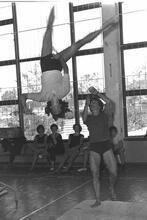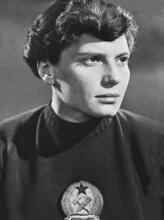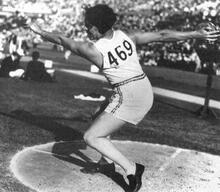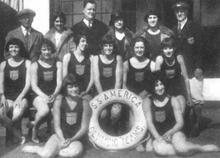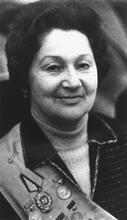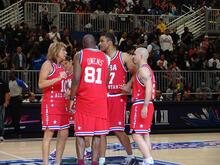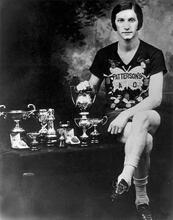Gretel Bergmann
Gretel Bergmann was a highly successful German track and field athlete. After German sports organizations began adopting “Aryan laws” in 1933, Bergmann joined the sports team at London Polytechnic and became the British high jump champion in 1934. Preceding the 1936 Berlin Olympics, Nazi leaders who wanted to evade accusations of racism invited Bergmann to return to Germany to participate in Olympic preparations. While Jewish athletes were forced to train in poor conditions, Bergmann was the only Jew permitted to attend a training camp, and subsequently the only Jewish athlete to improve her performance. Despite the fact that she tied the German high jump record of 1.60 meters, the Nazis denied Bergmann entrance to the German team. Disillusioned, Bergmann immigrated to the United States in 1937. She won the US Championship in high jump in 1937 and 1938.
It should come as no surprise that Gretel Bergmann could never forget Germany and everything that she had experienced in that country. But what is astonishing is that it was not the loss of a homeland but rather her exclusion from the Olympic Games that led her to complain. She felt she had had been deprived of “the thrill of a lifetime… simply because I was born as a Jew,” an indication of the important role sport played in her life.
Early Life
Margarethe Bergmann was born on December 4, 1914, in Laupheim, a small town in upper Swabia near Württenberg, where her parents’ families had lived since the 1870s, in comfortable circumstances and respected by their neighbors. Judaism played no part in the lives of this German-nationalistically inclined family.
From childhood on, Gretel Bergmann was always enthusiastic about sport and engaged in many types of sport, including running, swimming, tennis, and skiing. Whatever free time she had was spent at the gymnastics and sport society club in her hometown and from the age of ten she competed successfully in various light athletics competitions.
Gretel Bergmann attended the town’s modern secondary school, a boy’s school where she fit in well. She behaved like a boy and played handball and soccer with her fellow pupils. After switching to a gymnasium [high school] in Ulm she joined that town’s soccer association, which also had a good athletics department. At last she was able to take part in professional and systematic training and her achievements constantly improved, with the high jump emerging as her specialty. In 1933 her jump of 1.51 m. placed her among the best in Germany.
Impact of the “Aryan Laws”
With the Nazi ascent to power, Jewish life in Germany underwent a rapid and radical change. In their desire to win the support of the new powers-that-be, sports associations from April 1933 on eagerly implemented the “Aryan laws,” which excluded Jewish men and women from their organizations. This proved a stimulus for Jewish sports organizations, which the Nazis at first tolerated, in part because in the run-up to the Olympic games they wanted to show the world press and the International Olympic Committee (IOC) that Jewish sportsmen and women enjoyed equal opportunities.
In 1933 Gretel Bergmann not only had to abandon her desire to study at the German College for Gymnastics in Berlin, but also to forgo her membership in the Ulm Soccer Association when it was “aryanized.” The Bergmanns soon realized that there was no future for Jews in Germany. Edwin Bergmann took advantage of a business trip to London to register his daughter at the London Polytechnic, where she was immediately accepted into the college’s sports teams. In June 1934 she became the British high jump champion with a jump of 1.55 m.
Olympic Preparations
In 1934 Gretel Bergmann had to return to Germany to participate in the preparations for the 1936 Olympic Games, since a refusal to do so might have had negative results not only for her family but also for Jewish sport organizations. The sports leaders of the Reich were interested in having Jewish champions participate in the preparation and the selection competitions in order to counter international charges of racism. Under international pressure, particularly from the United States, the IOC had insisted on a guarantee that German Jews would be permitted to participate in the Olympic Games. Thus, in order to recruit potential participants, those living abroad were bidden to return. Nevertheless, although she was a potential participant in the Olympics, Gretel Bergmann was permitted entry only into Jewish associations. In the late summer of 1934 she was able to practice for the Games only at the facilities of the Reichsbund jüdischer Frontsoldaten (Jewish Frontline Soldiers) in Stuttgart. At the same time she completed a two-year training course for gymnastics teachers at the Kiedaisch Sports School, one of the few that were still allowed to accept Jews who were children of World War I veterans.
In the meantime Germany had begun intense preparations for the Olympics. While “Aryan” athletes of both sexes received enormous support, the Jews had to train in poor conditions. Gretel Bergmann was the only Jew permitted to attend a training camp in autumn 1934 and spring 1936. Her recollection of a good atmosphere among the women participants are borne out by her fellow participants. She had a particularly good relationship with her high-jump colleague, Elfriede Kaun.
In 1935 Gretel Bergmann was invited to a screening course of Jewish athletes, at which it clearly emerged that, as a result of the bad conditions under which they had trained, their achievements were far below the German peak. Here Gretel Bergmann first met the long jump athlete Bruno Lambert, whom she later married.
Gretel Bergmann was the only one among the Jewish athletes who continuously improved her performance. At the Württenberg Championship in 1936 she reached 1.60 m. in the high jump, which was the German record attained by Elfriede Kaun. Since this seemed to have won her entrance into the Olympic Games, she was surprised to learn on July 16 that her performance did not qualify her for nomination to the German team. Only two athletes were nominated for the women’s high jump, Kaun and Dora Ratjen. The national-socialists thus forwent the advantage of a good chance to win a medal only so as not to have to accept a Jew onto their team.
Since the American team was already en route to the Games at the time of Bergmann’s exclusion, no major protest on their part was to be expected. The German participants were told that an injury prevented Bergmann from participating. In the end, only “half-Jews” were included on the German team: Rudi Ball, one of the most popular of German ice-hockey players, and Helene Mayer, a fencer from Offenbach, who was teaching at an American college at the time.
Immigration to the United States
With no hope of any future in Germany, Gretel Bergmann decided to emigrate to the United States. Shortly before her departure she happened to meet her fellow athlete, Bruno Lambert, and the two fell in love. In May 1937 Gretel Bergmann left Germany, determined “never to set foot on German soil again” (Diederix 1993, 96).
In the United States Bergmann took various jobs and enabled Lambert, who had meanwhile studied medicine, to emigrate. They married in September 1938. Although he found employment as an assistant physician, he was compelled to work for a very low salary. Gretel Bergmann worked as his assistant and thus helped earn their living.
Gretel Bergmann remained active in sport until the outbreak of World War II. In 1937 she won the U.S. Championship in high jump and shot put and in 1938 again won the high jump championship. After the war Bruno established his own practice in internal medicine in New York, while Gretel cared for their sons, born in 1947 and 1951. Golf and bowling were her favorite leisure activities.
Recognition & Legacy
For many years it seemed as if Bergmann and her fate had been forgotten. Only with her entry into the Jewish Hall of Fame at the Wingate Institute in Israel in 1980 was interest in her revived. In Germany she was awarded the Honorary Plaque of the Field and Track Association and honorary membership in the Laupheim Gymnastics and Sport Club. In 1995 she was entered into the Jewish Hall of Fame in New York and the same year a Berlin stadium was named for her. Other honors followed.
In 1999 Bergmann broke her oath never to visit Germany. Adam Opel AG Deutschland awarded her the distinguished Georg von Opel Prize, given to persons who have distinguished themselves in sport and its principles. At the same time, she visited her native town, which renamed its municipal stadium after her. Gretel Bergmann thus succeeded “putting an end to her long battle with anger” (Diederix 2001, 27).
Bergmann, Gretel “Ich war die große jüdische Hoffnung,” edited by Haus der Geschichte Baden-Württemberg. Karlsruhe: 2003.
Bernett, Hajo. “Frauengeschichten” von den Olympischen Spielen 1936. Olympisches Feuer 46 (1996): 6, 29–40.
Bernett, Hajo. Der jüdische Sport im nationalsozialistischen Deutschland. Schorndorf: Hoffman, 1978.
Diederix, C. “Die Judenfrage im Sport.” Unpublished Master Thesis, Stuttgart, 1993.
Idem. “Ausgegrenzt–ausgebootet–zur Flucht getrieben. Die Lebensgeschichte der jüdischen Hochspringerin Gretel Bergmann.” SportZeit 1, no. 2 (2001): 7-17.
Krüger, Arnd “Wenn die Olympiade vorbei, schlagen wir die Juden zu Brei!” Das Verhältnis der Juden zu den Olympischen Spielen von 1936. In Menora. Jahrbuch für deutsch-jüdische Geschichte, edited by Schoeps, J. H. et al. München: 1994, 331–348.
Siegman, Joseph, ed. The International Jewish Sports Hall of Fame. Jewish Sports Legends. Washington & London: N.p., 1972. 171–172.
Teichler, Hans Joachim. “Zum Ausschluß der deutschen Juden von den Olympischen Spielen 1936." In 30 Jahre jüdische Sportbewegung im Nachkriegsdeutschland. Makkabi Deutschland, Friedler, E. and Lenarz, M. (Red.). München: 1995, 47–62.
Teichler, Hans Joachim. Internationale Sportpolitik im Dritten Reich. Schorndorf: Hoffman, 1991.

